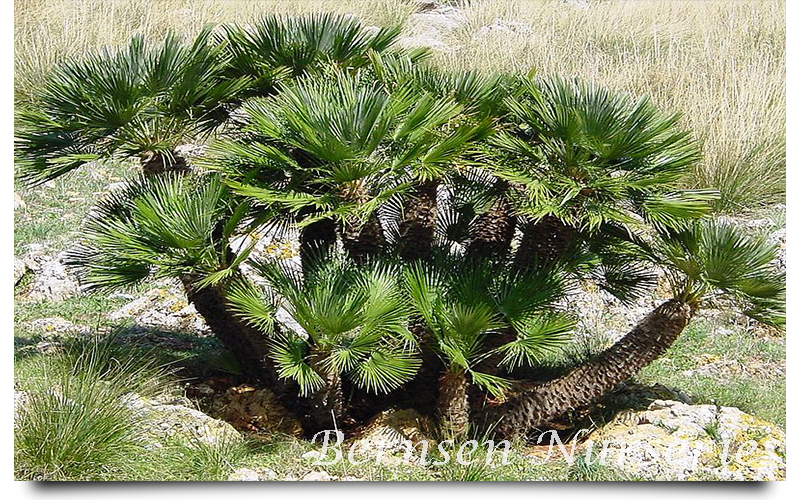MEDITERRANEAN FAN PALM
Bring a bit of the tropics to your garden, even in a cooler climate, with the Mediterranean fan palm (Chamaerops humilis). Also known as the European fan palm, it is the only palm native to Europe and grows in Sunset’s Climate Zones H1, H2 and 4 through 24.
Mediterranean Fan Palms grow less than 6 inches per year to a height of about 20 feet. They form clumps and send out small “pups” that become part of a palm grouping that can be used effectively as a large shrub. With a little forethought about location, you can establish a Mediterranean fan palm in your landscape that will become a lush, attractive addition to your surroundings.
Cold hardy Mediterranean Fan Palm trees are as versatile as beautiful. With the leaves trimmed up to clear the trunk it makes a beautiful specimen plant a natural sculpture to grace your patio or entryway. Unpruned, Chamaerops humilis assume an attractive shrubby form. Use them as screens or plant several side by side to form barriers. Planted in groupings they will accent that hard-to-garden, bare corner of your yard. Mediterranean Fan Palm trees are excellent in containers and urns.
This small, multi-stemmed, hardy Mediterranean Fan palm is the only one native to Europe, and is hardier than most palms. The curved, clumping, short trunks and gray-green, fan-shaped leaves, borne thickly in a bushy head, make a stunning sculptural element in a garden or patio containers. The finetextured fronds make the palm stand out from other plants in the landscape. Leaf color on individual plants ranges from light green through silver. Although growth rate is slow, it is well worth the wait since even small plants will stand out nicely in almost any landscape.
Step 1 Select a spot in your garden with good drainage in full sun, well away from structures, walkways or other plants. The Mediterranean fan palm generally grows into the space provided, so afford it lots of room.
Step 2 Dig a hole whose width is twice the diameter of the container of the Mediterranean fan palm. Dig the hole deep enough to accommodate the root ball plus 6 inches. There will be an obvious lip around the base of the trunk that forms the top of the root zone; measure the depth of the root ball from this lip to the bottom of the container.
Step 3 Amend the soil you remove from the hole with a little compost; the Mediterranean fan palm does not need dense nutrition. Further amend heavy clay soil with sand to improve drainage.
Step 4 Fill in the bottom of the hole with the amended soil and pack it firmly. The packed earth should take up 6 inches at the bottom of the hole.
Step 5 Tap the sides of the Mediterranean fan palm container to loosen the root ball from it. Gently slide the entire root ball out of the container and set it in the hole. The lip of the root zone should be no more than 1 inch below ground and should never be above the surface.
Step 6 Ensure the trunk is vertical and fill in around the root ball with the amended soil about half way up the root ball, filling in any gaps between the roots. If the gaps are hard to reach, use a hose to force water into the hole and drive the soil into the gaps. Pack the soil firmly around the root ball.
Step 7 Fill the rest of the hole with the amended soil, continuing to fill in any gaps. Pack the soil firmly around the root ball. Water well to compact the soil further.
Step 8 Spread 1 to 3 inches of bark or leaf mulch around the base of the Mediterranean fan palm to help it retain water. Drive a stake next to large palms, being careful not to damage the roots, and tie the palm to the stake with nylon mesh to help support it.
Step 9 Water the newly planted Mediterranean fan palm deeply every other day, but do not water it if it rains; the ground must drain of water completely between watering. Water the base only, not the leaves, and extend the watering zone about 10 inches past the root ball. If drainage is too quick, mound a small, circular berm of soil around the base of the palm just outside the root ball circumference to help retain water. Gradually taper off watering after about 6 months; the Mediterranean fan palm will eventually become accustomed to the local rain conditions and will not need extra water.

